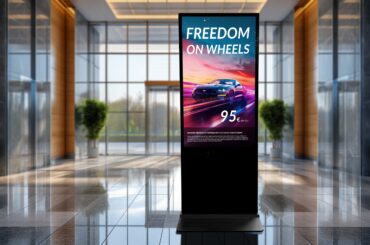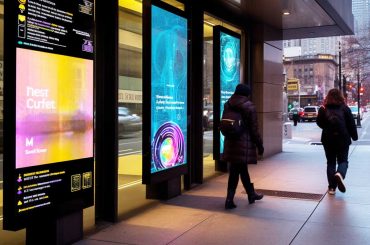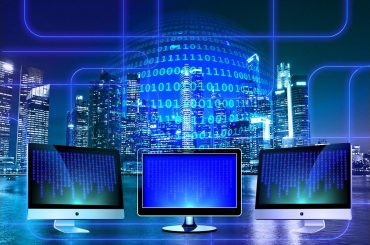Stores are increasingly fitted with sensors that can locate the shopper’s whereabouts inside the store, in order to present customized special offers to the shoppers’ smartphones or tablet PCs. We are talking about beacons here.
An application that is supposed to counter the growing challenge of a moving shopping experience towards mobile usage. This blog post will give you information on whether small and medium-sized enterprises can make use of beacon-technologies and how it’s done. But also on how this technology will support your digital signage presentation.
What exactly are Beacons?
Beacons are small hardware components that provide active presence detection in order to control devices automatically. This works through the pre-creation of so-called SUMITs via a special app, over which required actions will subsequently be performed. In particular, this means that e.g
- lights will automatically turn on when you come home,
- the TV automatically switches off after watching a movie at night,
or that
- your personal favorite music will always be played in the exact room in which you are located at the current time.
It happens all by itself. There is no need to take your smartphone out of your bag anymore.
Another useful side effect? It’s energy saving.
Explaining the Beacon-Technology
The whole secret behind beacon’s functionality? Small, embedded chips that hold an advanced Bluetooth technology called Bluetooth Low Energy, short BLE.
It provides the ability to track incoming and outgoing items as well as persons in premises over radio frequencies. While BLE-technology has been known for quite some time now, it has mainly grown in connection to the main marketer Apple and its launched ibeacon technology.
In order to manage the ibeacon hardware, customers must be in possession of a compatible smartphone and the appropriate app. The app thereby enables push notifications to be presented on smartphones and special offers, discounts or product information to be easily accessible.
The advantages of Beacons in Terms of Digital Signage?
All kinds of stores are supposed to be equipped with the new ibeacons-technology in the future in order to locate customers and to place real time information and offers on mobile devices.
ibeacons will also help customers to find their way inside the store which is why they will increasingly be used in Digital Signage. Thus, the technology will not only transmit signals to mobile devices but also communicate with digital signage players.
See an example:
A customer receives latest offerings about sports shoes on his or hers mobile device while the brand’s image video is being displayed on screens in the near environment. See, multimedia networking allows shopping experiences to be unique and creates personalized PoS or PoP communications.
Networking of Beacons and
Digital Signage in retail
Retailers are therefore facing increasing and much better opportunities to make use of captured consumer data right where it’s needed: for instance, as soon as a customer enters the store, he or she will personally be welcomed through push notifications and at the same time be adverted to latest offerings. And when the customer searches for these products, then other matching products are pointed out to the shopper on digital signage screens, of course.
Obstacles to overcome
With rising demand for ibeacons in digital signage, obstacles will occur in the future. In fact, It’s not beacons themselves that send out data to the customer’s smartphone. The technology only recognizes the customer in the near environment, while data, that is supposed to be transferred to the customer’s mobile device, has to be generated and provided by a web server first.
So first of all, Retailers will need the appropriate app to do exactly that. They will have the opportunity to
a) develop an own app or
b) use a common app with other shop owners.
Neither of these options, however, is the ideal solution, since customers won’t download one app for each retail store and since retailers won’t want to compete with other shop owners through the usage of the exact same app. Only large companies, such as Zara containing a broad app user base, can use beacons supportively so far.
Mobile devices containing new BLE-Technology
The new iPhone and iPad generation is already equipped with the new BLE-technology. Meaning, all devices since the launch of the iPhone 4s and the third generation iPads do support Apple’s ibeacon technology. Therefore, the installation of iOS 7 is required.
Beacons can also be controlled by Android devices insofar as they’re at least equipped with version 4.3. Although some older devices already include the Bluetooth 4.0 technology, they do not run the latest operating system. Samsung as well already works on integrating BLE-technology into Android mobile phones, precluding the need for any app being installed.
Conclusion
ibeacons are becoming more and more ubiquitous on the international market. Used in connection to digital signage, ibeacons might even elevate to a new level as long as the technology faces growing and ongoing acceptance by customers and consumers.
Experts see beacons revolutionizing the retail market pretty soon. Not least because intelligent and profile-based messages can be sent to mobile devices and transmitted to digital signage solutions in our environment as well when both technologies are working together. And since previous purchases are also taken into account, customers can specifically be informed about preferred products – just like Amazon does with personal shopping recommendations.
In order to compete with online retailers, this technology will probably be very ubiquitous in regular retail stores in the future.





